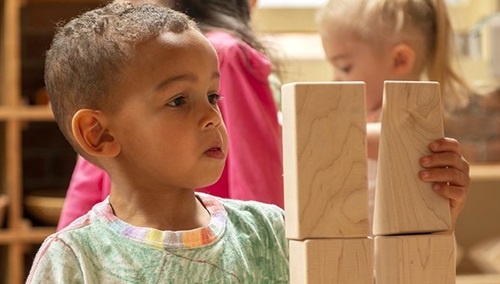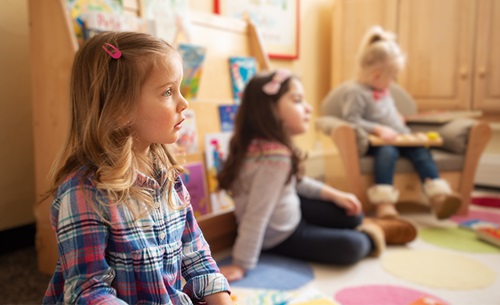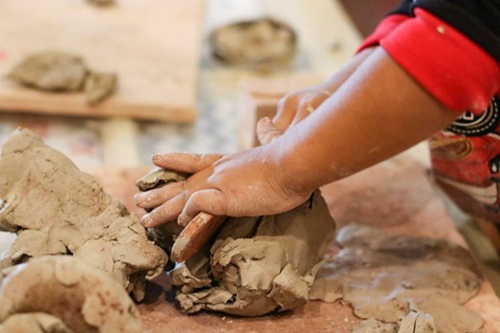Play: Children’s Context for Development
| May 2009Children’s surroundings provide a world for exploration, discovery, and enjoyment. Playing is what young children spend most of their time doing from the moment they wake up until they close their eyes at night.
The four-year-olds are busy. “Go get some muffins, and we’ll jump into the car,” Sophie orders Nicholas. She and Issy run hand in hand to the slide. Underneath the slide their car awaits them—and their plan for a getaway.
Nicholas comes running back, his hands held out. “Here are the muffins,” he says as he hands Sophie and Issy each a piece of warm, buttered air. “I’ll drive,” he says, skootching in to the driver’s seat.
Sophie and Issy wiggle backward to make room for their friend. Nicholas sits with his arms held out in front of him, gripping an invisible steering wheel. The girls wrap their legs around the person ahead, placing their hands on that child’s shoulders—a three-child chain.
“Can I come with you?” yells Nina just before the car takes off. “Sure!” hollers Sophie. “Hop in the back.” Nina joins the chain, and with engine sounds they zoom away.
Grasping the significance of play helps us see inside the child’s world and appreciate the impact playing has on development and learning. Through play, children learn about cultural norms and expectations, discover the workings of the world, and negotiate their way through their surroundings. Play teaches children about themselves, others, rules, consequences, and how things go together or come apart.
The importance of play is not accepted universally (Landreth 1993). Play is viewed by some as the opposite of work; play does not mean learning. Play is often trivialized in sayings like “That is mere child’s play” or “He is only playing,” as if to say play is unimportant. Many would prefer that young children spend their time tracing letters or matching figures on a worksheet. This article defines the elements of play, illuminating its central role in young children’s learning and development. The focus is on toddlers and preschoolers, age groups that spend most of their time involved in exploration and play (Fein 1981; Piaget [1962] 1999). Also addressed is the critical role of adults in supporting and extending children’s play.
Characteristics of Play
There is no universal definition of play. This is hardly surprising given that behaviors at one developmental stage can take on new meaning or functions at another stage (Howes 1992). Yet there are certain agreed-upon behavioral characteristics of play (Rubin, Fein, & Vandenberg 1983). The major defining characteristics of play are positive affect, active engagement, intrinsic motivation, freedom from external rules, attention to process rather than product, and nonliterality.
Positive affect refers to children’s enjoyment of play as shown in their laughter, smiles, singing, and expressions of joy while playing (Shaefer 1993). Like adults, children seek enjoyable experiences and work to continue them; pleasure sustains the activity.
Children’s enjoyment of play is paired with another element, active engagement—deep involvement without distraction. Although this characteristic seems obvious, it is an important attribute; play fully absorbs children’s interest.
Closely related to engagement and enjoyment is perhaps the most widely agreed-upon aspect of play—a child’s intrinsic, or internal, motivation to play (Shaefer 1993). Different factors can motivate a child; novelty, gaining a new angle on a familiar experience, achieving mastery with known objects, needing to work through feelings. Although the motivation comes from the child, adults establish a safe environment and support or assist in the play.
Adults have an important role, but they do not make the rules for play. Instead, play occurs outside external rules as the rules and structure governing play come from the children (Landreth 1993).
Freedom from external rules does not mean the total absence of rules. Children set rules, governing roles, relationships, entry into play, plot development, and acceptable behaviors (Fein 1981). The players develop and agree upon the rules, which are implicitly understood.
The children have distributed roles and created a structure for their pretend play to succeed. While the activity leads to a successful cleanup, the pretend aspects are what engage the children and sustain the play.
During play, young children focus on the process or performance of the activity, not on a goal or the results (Landreth 1993). It is this aspect in part that separates play from work. Here, the process is the activity; it keeps the children involved, exploring and discovering without a defined beginning or end. Players set the goals, and the goals can change in importance according to desire (Rubin, Fein, & Vandenberg 1983). The process allows play to take new directions and be transformed, curtailed, or extended spontaneously and without disruption to the activity.
Adults establish and guide the play environment. The environment serves to significantly facilitate the process of play.
Lissa grabs a blob of blue playdough. She sticks tongue depressors upright in the playdough and holds the concoction out toward her friend. With a wide smile she sings, “Happy birthday to me…”
For the moment it is Lissa’s birthday. The teacher builds on Lissa’s fantasy (“It’s your birthday. Will you have a party?”), guiding her to extend her play.
Exploring—gaining information about an object—is a foundation that often leads to playing. In exploration children ask, “What is this? What can it do?” The inquiry process enables discovery, familiarization, and feelings of competence and security. (“This is something that I know”). By asking open-ended questions (“What does that feel like? What can you do with it?”), adults invite an unengaged child to participate and to expand the involvement of those already engaged (Tegano, Sawyers, & Moran 1989).
How does play support learning and development?
Enrichment and growth naturally evolve from playing as children learn about themselves and their surroundings. A child’s active participation in his or her world facilitates mastery and control, leading to feelings of competence and self-efficacy. Both contribute to young children’s sense of self (Pruett 1999). The internal excitement derived from discovery and mastery nurtures children’s innate desire to learn. This passion and internalized sense of accomplishment is what motivates children’s learning.
Play lets children make important discoveries about the self—including their own likes and dislikes. They continually shift activities to maximize pleasure, while discovering what is easy and hard to do and what makes them happy or frustrated. They learn to understand the feelings of others and develop empathy. These skills are crucial for healthy peer relationships.
Play fosters language skills. Pretend play encourages language development as children negotiate roles, set up a structure, and interact in their respective roles (Garvey [1977] 1990). Adults support language by commenting on or labeling children’s play (“I see you are washing that baby,” “That’s a big blue painting you’re making!”). Such comments provide a language-rich environment and naturally reinforce concepts and build on the play.
Language is tied to emotions, which are expressed and explored through pretend play (Slade 1994). Pretending gives children the freedom to address feelings, anxieties, and fears. Through fantasy, children re-create and modify experiences to their liking. They foster a sense of comprehension, control, and mastery (Schaefer 1993). This can enhance feelings of security.
Becoming a ferocious lion allows Sharie to put aside the timid child who fears leaving her mother. Instead, being a fierce animal lets her test the waters and helps her cross into the classroom with confidence. The teacher can encourage or welcome the lion into the forest, noting the scary growl and offering materials like blankets to make a lion’s den. In time, the lion will disappear and Sharie will enter the classroom as herself.
Adults can continue to reinforce and extend the play to sustain children’s interest, or they can enter the play directly if invited. Labeling feelings and reflecting on emotional content is an effective way to extend fantasy play: “That lion sounds so angry.” It can help children understand feelings by saying, “Why do you think that monster is so sad?”
Play is a vehicle for expressing feelings, with minimal language needed. Moving feelings from the child to the pretend character reduces anxiety and frees the child to explore emotions. The adult’s message is “It is safe to have and express these feelings.”
Play teaches children about the social world. It provides opportunities to rehearse social skills and learn about acceptable peer behavior firsthand. With age and experience, children’s awareness of peers playing around them increases. This leads to more interactions between children and incorporation of peers into their play (Parten 1932). Group play provides a stage for rehearsing peer skills and learning to be a community member.
Both social and solitary play provide opportunities for children to practice problem solving and negotiating—skills needed to achieve competency in learning, in social relationships and in being a group member.

Conclusion
A child’s world is filled with the magic of exploration, discovery, make-believe, and play—vehicles for development. Much of children’s early learning comes through self-discovery—an outcome of play. We have defined and illustrated the elements of play as a way to better understand its essential parts, the development it fosters, and the adult’s crucial role as a supporter of the play process.
Play is young children’s most familiar and comfortable tool for engaging the world, with adults as essential scaffolds. Using observation and intervention aligned to children’s developmental capabilities, adults provide a bridge from children’s current to their future language, cognitive, social, and emotional processes.
For children, play is a dialogue with their surroundings—indoors or out, pretending or exploring, talking or being quiet, alone or with others. The rich complexities and subtleties offered through play provide a base for ongoing development. Not all children have opportunities to play in safe environments, but certainly all children deserve the chance to do so.
Excerpts from an article by Tovah P. Klein, Daniele Wirth and Keri Linas, published in NAEYC’s journal Spotlight on Young Children and Play, 2004.
Reprinted, with permission, from the National Association for the Education of Young Children









